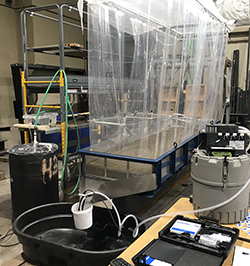
The practice of spreading wastewater from conventional oil and gas wells is unsuitable for dust suppression on unpaved roads, according to Penn State researchers. Their findings will be considered as the Pennsylvania Department of Environmental Protection reviews its policies toward the practice, halted in Pennsylvania in 2018. Pictured here, from left to right: Bill Burgos, professor of environmental engineering; Andrew Kearney, environmental engineering research assistant; and James Farnan and Andrew Eck, both environmental engineering graduate students. Credit: Kelby Hochreiter / Penn State. All Rights Reserved.
Oil and gas brine control dust ‘no better’ than rainwater, researchers find
Wastewater, commonly used as a dust suppressant for unpaved roads, also has significant environmental implications.
May 26, 2022
By Tim Schley and Ashley J. WennersHerron
UNIVERSITY PARK, Pa. — Spreading wastewater, or brine, from conventional oil and gas wells on unpaved roads is a longstanding practice for suppressing dust, which can become a breathing and visibility hazard during warmer months. Common in several other states, the practice was halted in Pennsylvania in 2018 and is under evaluation by the Pennsylvania Department of Environmental Protection (DEP). The DEP commissioned a study by Penn State researchers, who found that the brine is about as effective as rainwater at controlling dust but worse for the environment.
The DEP finalized the report today (May 26).
Using oil and gas wastewater from conventional wells to control dust was considered a beneficial use of the residual waste on the state’s 25,000 miles of dirt and gravel roads, since it was thought to have a chemical composition and behavior similar to commercial dust suppression products. A previous 2021 study, also conducted by Penn State researchers, indicated otherwise. This new study, partly funded by the DEP, reinforced those conclusions, while also finding that the rain runoff from roads treated by any dust suppression method contained contaminants that could pollute nearby water sources.
Together, the ineffectiveness and potential pollution of wastewater spreading make the practice an unsuitable alternative for dust suppression on Pennsylvania roads, the team reported to the DEP’s Office of Oil and Gas Management.
“I’d like to thank the researchers at Penn State for putting this report together and for the important information it contains,” said Patrick McDonnell, secretary of the DEP. “We will evaluate this data for use in decision making about brine spreading on Pennsylvania roadways.”
“We know that road dust poses both a safety hazard for people driving through it and a health hazard for people breathing it in, so dust suppressants are absolutely needed,” said co-lead author Bill Burgos, professor of environmental engineering. “While we must be willing to accept the tradeoffs between the benefits of dust suppression and the drawback of the environmental impacts, this research has found that oil and gas wastewaters only provide drawbacks.”
The report summarized the results of two laboratory-scale studies comparing samples of oil and gas wastewater from conventional wells to the commercially available calcium chloride dust suppressant and the organic alternative of soybean oil.
In one set of laboratory experiments designed to study the impact of rain runoff after dust suppression, researchers found that every suppressant tested leached contaminants in proportion to its chemical composition. The runoff from roadbeds treated with calcium chloride, a commercial suppressant, contained the highest concentrations of chlorides and other potential contaminants related to the salinization of freshwater resources. The runoff from roadbeds treated with oil and gas wastewater also contained chlorides, as well as high concentrations of sodium and even radium — a known carcinogen that is often pulled to the surface through wastewater when oil and gas is extracted from the Earth.
In the report, the researchers recommended the DEP analyze brine composition prior to use and implement limits on the various contaminants.
“After a dust suppressant is applied to a road, the first rainfall begins to wash it off the surface,” said co-lead author Nathaniel Warner, assistant professor of environmental engineering. “The research found that the runoff contains high concentrations of whatever is put on the road and could cause problems in nearby water — the sodium, chlorides and particularly the radium are all of serious concern.”
In experiments testing dust generation, conducted with compacted “pucks” of gravel road material subjected to a laboratory analogue of traffic abrasion, calcium chloride and soybean oil were shown to be highly effective at suppressing dust. The oil and gas wastewater performed “essentially no better than rainwater,” likely due to its high concentration of sodium, according to Warner.
He added that the amount of sodium relative to calcium and magnesium, called the sodium absorption ratio or SAR, can be used to help evaluate dust suppression efficacy. Sodium, calcium and magnesium are all positively charged, but calcium and magnesium have a higher charge and stick more easily to the negatively charged dust particles. The researchers developed the SAR metric in their 2021 study.
In addition to lessening effectiveness, the sodium in wastewater can also destabilize the road, leading to more dust, as well as increased long-term maintenance costs, according to Eric Chase, research assistant with Penn State’s Center for Dirt and Gravel Road Studies and co-author of the report.
“There’s a fair bit of literature out there showing that sodium will actually cause your road to fall apart,” Chase said.
According to Burgos, before the practice was halted in Pennsylvania in 2018, townships often turned to oil and gas wastewater from conventional wells for dust suppression because it was a cost-effective alternative to commercial products.
Additional contributors included Xiaofeng Liu, associate professor of civil and environmental engineering; Hassan Ismail, postdoctoral research associate, and Andrew Kearney, research assistant, both in Penn State’s Department of Civil and Environmental Engineering; and James Farnan and Andrew Eck, graduate students in environmental engineering.
The DEP funded the runoff experiments. Penn State funded the brine efficacy experiments.




